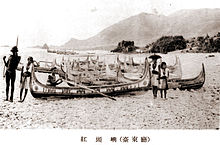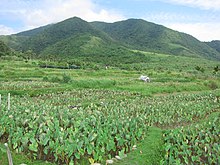Lan Yu (island)
|
Lan Yu 蘭嶼 |
||
 Location Lan Yu, off the east coast of Taitung County |
||
| State : |
|
|
| County : | Taitung | |
| Coordinates : | 22 ° 3 ' N , 121 ° 32' E | |
| Area : | 48.3892 km² | |
| Residents : | 4,743 (2012-06) | |
| Population density : | 98 inhabitants per km² | |
| Time zone : | UTC + 8 (Chungyuan time) | |
| ISO 3166-2 : | TW-TTT | |
| Community type : | Rural community | |
| Structure : | 4 villages ( 村 , cūn ) | |
|
|
||
Lan Yu (also: Orchid Island , Chinese 蘭嶼 / 兰屿 , Pinyin Lán yǔ , W.-G. Lan Yu , Zhuyin ㄌ ㄢ 'ㄩ ) is a 45 km² large volcanic island off the southeastern coast of Taiwan . It is administered by the Republic of China (Taiwan) as Lanyu Township in Taitung County .
Geography and population
The main island is a maximum of 13.3 kilometers long and 7.3 kilometers wide. Eight mountains on the island are higher than 400 m, the highest is the Hongtoushan (紅 頭 山) at 552 m . There is a small uninhabited side island, the "Small Ochid Island" ( Chinese 小 蘭嶼 , Pinyin Xiao Lanyu ).
The island of Lan Yu, on which 5,157 people live (as of 2018), is home to the Tau ( Chinese 達 悟 族 / 达 悟 族 , Pinyin Dáwùzú ), one of the indigenous peoples of Taiwan recognized as an ethnic minority . The Tau immigrated from the Batan Islands in the south of the Philippines , which are separated from Lan Yu by the Bashi Trench in the Luzon Strait , about 800 years ago . They call the island Ponso no Tao or Pongso no Tawo (island of the people) or Irala . The island is also known as the Botel Tobago . The Ami call Buturu , the Puyuma Botol .
The islanders live as farmers from the cultivation of taro , yams and millet and as fishermen in particular from catching large quantities of flying fish . The island can be reached by sea and air. The airline Daily Air offers several daily flights from Taitung (weather permitting) , there are ferry connections from the port of Fukang near Taitung.
climate
The island has a subtropical monsoon climate . In the following table, rainy days are defined as days with precipitation over 0.1 mm.
| Lan Yu (Orchid Island) | ||||||||||||||||||||||||||||||||||||||||||||||||
|---|---|---|---|---|---|---|---|---|---|---|---|---|---|---|---|---|---|---|---|---|---|---|---|---|---|---|---|---|---|---|---|---|---|---|---|---|---|---|---|---|---|---|---|---|---|---|---|---|
| Climate diagram | ||||||||||||||||||||||||||||||||||||||||||||||||
| ||||||||||||||||||||||||||||||||||||||||||||||||
|
Climate data from the years 1981–2010
Source: Taiwan Central Weather Bureau
|
||||||||||||||||||||||||||||||||||||||||||||||||||||||||||||||||||||||||||||||||||||||||||||||||||||||||||||||||||||||||||||||||||||||||||||||||||||||
history

The island was first recorded on Japanese nautical charts in the early 17th century as Tabako-shima, and on a French nautical chart from 1654 as Tabaco Xima. The Chinese who had contact with the inhabitants called them Hongtou Yu (紅 頭 嶼 "Red-Headed Island"), from which the name Kōtō-sho comes from during the Japanese rule over Taiwan . The Japanese colonial government declared the island to be an ethnological research area, closed to the public. After the Republic of China came to power in 1946, it was blocked until 1967. Hence, the traditions of the tau are the best preserved of the indigenous peoples of Taiwan . After 1967 schools were built and compulsory education with classes in standard Chinese was introduced. Tourism on the island has also increased.
On January 19, 1946, the island became Hongtouyu Township (紅 頭 嶼 鄉) in Taitung County. On November 24th of the same year it was renamed Lan Yu (蘭嶼, translated: "Orchid Island"), after the orchids of the genus Phalaenopsis found there .
Prison island
From 1958 to 1972 much of the island was confiscated in order to establish farms for retired soldiers and a prison for criminals. The Tau complained that outdoor detainees stole their property and raped women, but the authorities seldom took this seriously as they never witnessed the assault themselves.
Radioactive waste warehouse
In 1974, the Atomic Energy Agency of the Republic of China selected an area on the southern tip of the island as a "temporary" storage facility for radioactive waste . In fact, it should absorb 18,000 tons over a 50 year period. The government deceived the Tau commissioner, an illiterate man , by claiming that it wanted to build a canned fish factory and that it needed his signature to approve the project. A port was built in 1978, and construction of the camp began in 1980. During this time, the veils against islanders were maintained until churchgoers learned the truth from the Taiwanese news. The first shiploads of light and medium-level radioactive waste arrived in May 1982 from Taiwan's three nuclear power plants operated by the state-owned Taiwanese energy supplier Taipower . More than 4800 tons are stored in 23 concrete pits on the island without a permit.
The situation received nationwide attention in 1991 when Kou Jian-ping, a Presbyterian missionary, held demonstrations in Taipei with the support of anti-nuclear groups and handed Taipower a letter with three demands: to stop the expansion of the second phase of construction of the camp; immediate stop of the shipment of radioactive waste to the Orchid Islands and the closure of the warehouse until July 30, 1991. Taipower fulfilled the first requirement, and in 1996 also the second. However, the warehouse is still in operation. The Executive Yuan is expected to find a final location to store the radioactive waste and complete the construction of a repository by 2016. The government was negotiating with Russia , the People's Republic of China , North Korea and the Solomon Islands over the shipping and storage of Taiwanese radioactive waste.
Over half of the island's population protested outside the nuclear waste dump in 2002 because the government failed to keep its promise to remove 100,000 barrels of low-level radioactive waste from the island. Prime Minister Yu Shyi-kun apologized for not keeping promises and for not being able to say when and how the radioactive waste will be removed from the island given the lack of alternatives. The energy company Taipower offered the islanders the payment of NT $ 200 million (about € 4.3 million) in return for being able to operate the warehouse for another nine years.
During a visit to the island on August 17, 2016, the newly elected President Tsai Ing-wen assured residents that the circumstances that led to Lan Yu being selected as a nuclear waste dump would be investigated and that government agencies would help the islanders would work together to find a solution to the problem.
places
| Name of the tribe | Chinese name | Administrative headquarters (村) | |
|---|---|---|---|
| Yayu | Yeyou | 椰油 | + |
| Iraralay | Langdao | 朗 島 | + |
| Iranumilk | Dongqing | 東 清 | + |
| Ivarinu | Yeyin | 野 銀 | Part of Dongqing |
| Imourud | Hongtou | 紅 頭 | + |
| Iratai | Yuren | 漁人 | With Imourud since 1946 |
| Iwatas | Yiwadaxi | 伊瓦達斯 | Joined Yayu in 1940 |
5.6 km south of the main island is the approximately 0.9 km² uninhabited so-called "small orchid island" Xiao Lan Yu (English Florano Island , Chinese 小 蘭嶼 / 小 兰屿 , Pinyin Xiǎo Lán Yǔ , W.-G. Hsiao Lan Yü ), which was used as a training target for military aircraft. It is home to the endemic orchid species Phalaenopsis equestris f. aurea .
There is a small airport on the island from which there are several daily flights to Taitung .
Web links
- Information from the Taipei Tourist Office
- Article about the dew on Spiegel Online
- Article of the taz about the orchid island Lan Yu
Individual evidence
- ^ Karl Theodor Stöpel: A journey into the interior of the island of Formosa and the first ascent of Niitakayama (Mount Morrison): Christmas 1898 . Companñía Sud-Americana de Billetes de Banco, Buenos Aires 1905 ( online (pdf) ).
- ^ Search for site for nation's nuclear waste continues . Taipei Times. November 14, 2006. Retrieved January 27, 2011.
- ^ Orchid Island launches new protests against nuclear waste . Kyodo. May 6, 2002. Archived from the original on July 8, 2012. Retrieved January 27, 2011.
- ↑ Oscar Chung: President Tsai visits Orchid Island again. Taiwan today, August 17, 2016; accessed September 14, 2017 .



